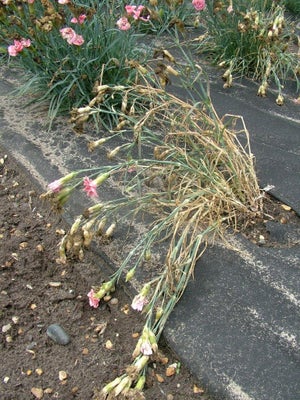
Quick facts
Common name - Fusarium wilt
Scientific name - Fusarium oxysporum
Plants affected - Various edible and ornamental plants, including asparagus, Callistephus (China aster), Dianthus (carnations, pinks), French/runner beans, hebe, peas, tomatoes
Main symptoms - Stunted plants with wilting leaves. Reddish staining of water-carrying (xylem) vessels in the stem. Root and sometimes stem rotting
Caused by - Fungus
Timing - Summer, particularly in hot weather
What is Fusarium wilt?
Fusarium wilt is a soil-borne fungal disease. It causes the water-carrying ( ) vessels to become blocked, so that the plant wilts and often dies.
Fusarium wilts are caused by pathogenic strains of Fusarium oxysporum, which are usually very host-specific. The disease can be very damaging on Callistephus (China aster) and Dianthus (carnations and pinks). There are occasional cases on other garden plants such as asparagus, cyclamen, French/runner beans, peas and tomatoes. In the last few years new Fusarium wilt diseases have been found on shrubby Veronica species (Hebe), stocks and glasshouse-grown lettuce.
Symptoms
You may see the following symptoms:
- Stunted growth
- Yellowing and wilting of the leaves
- Reddish discolouration of the , visible inside the stem as lines (if the stem is cut open lengthways) or dots (if it is cut across)
- White, pink or orange fungal growth on the outside of affected stems, particularly in wet conditions
- Root or stem decay – affected China asters often have blackened, rotting stem bases

Control
Non-chemical control
- Remove and dispose of affected plants as soon as possible
- Rest the soil from the affected plant type for at least 4-5 years, or replace the contaminated soil with fresh soil from another part of the garden
- Cultivars resistant to Fusarium wilt are available for some plants (e.g. peas and China aster) and could be tried in affected areas. Consult seed catalogues for further information
- Grafted vegetables are available, tomatoes for example, where the rootstock is not susceptible to Fusarium
- Obtain seed, and young plants from disease-free stocks of a reliable source
- If affected plants have been grown in pots, these should be disposed of (preferably) or treated with a disinfectant such as Jeyes Fluid. Also treat standing areas, capillary matting, etc.
Chemical control
There are no chemical controls available to gardeners for the control of Fusarium wilts.
Biology
The fungus Fusarium oxysporum is very common in the soil, where the majority of the population lives as a saprophyte (a harmless organism that feeds on dead organic matter). However, there are also a large number of pathogenic strains, which are able to infect different plants.
The pathogenic strains are known as formae speciales, abbreviated to f.sp. For example, Fusarium wilt of Callistephus is caused by Fusarium oxysporum f.sp. callistephi.
Infection usually occurs through the roots. The are blocked due to a combination of fungal growth and the production by the plant of gums and gels in response to the attack. The fungus also produces toxins that are carried up in the water stream.
Fusarium wilts are often diseases of hot weather and warm soils, although some can be troublesome at lower temperatures. They can be introduced into a garden on infected seeds, and young plants. The fungus produces long-lived resting spores (chlamydospores) that contaminate the soil for several years.
There are also strains of Fusarium oxysporum that affect bulbous plants such as daffodils, onions, tulips, irises and lilies. Rather than causing typical wilt symptoms as described above, on these plants the symptom consists of a decay of the bulb itself (often from the base), so the disease is usually known as basal rot or bulb rot.



